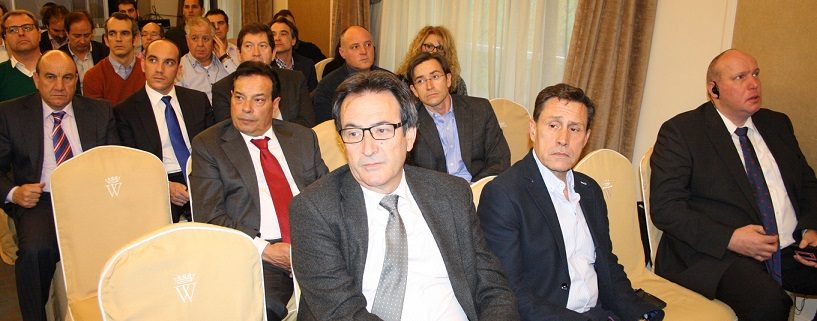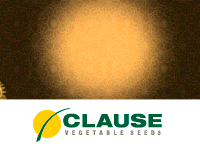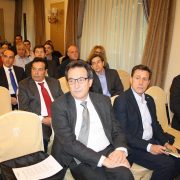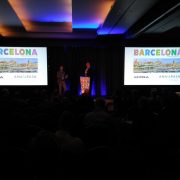ANAGRASA Congress focuses on management SANDACH PAT and export to third countries
“We formed the European Alliance, along with EFPRA and others as CESFAC, to pressure the European Commission (EC) in advancing the reintroduction processed animal protein (PAT) in the feeding of livestock species. It seems very disappointing to decide that revaluated and profitable product, can not be used when in the future agreement with the US will allow you to import pork, poultry and beef fed meat meal, “said Miguel Angel Higuera, director of the National Association of Producers of Pigs (ANPROGAPOR), which has shelled the potential of the sector in Spain.
“We start with a production of 3.9 million tonnes, assuming 37% of the Livestock Production and Final bill have reached 6,000 million euros,” Higuera been reviewed. The structural change within the industry is reflected in the census has increased sows in the past two years and grown large farms with more than 750 sows. Spain is the third largest exporter to the EU, up from 33% to non-EU destinations.
The pig sector is linked to processors of products of animal origin not intended for human consumption (SANDACH) as suppliers of raw materials for the manufacture of feed for animal feed, particularly animal fats from Category 3 but also as managers by-products generated in pig farms. “The delivery of the managing bodies is the majority choice, the relationship between management and livestock has improved and there are direct contracts, management and price for pig carcasses he is high,” mentioned the director of ANPROGAPOR.
“It is essential that we continue to be very close to the pig sector to give all guarantees in terms of biosecurity on farms with the collection and management of animal carcasses,” concluded Joan Vila Borrell, president of the National Association of processors Fat and animal (ANAGRASA).
European vision
Martin Alm, Technical Director and Second Vice EFPRA World Renderers Organization (WRO) explained what is currently happening in the EU regarding the situation of animal by-products processing enterprises in key legislative and above all, in the petition EU of the European Association of Animal By-Products Processing Industry (EFPRA) on the reintroduction of PAT ruminant animal feed. “It’s a brave struggle for some years, which can be achieved with perseverance we work within the Permanent Technical Committee EFPRA ago. In fact, there has been little progress, authorized in feed destined for aquaculture use, “he summarized.
Alm has evaluated the restrictions of Regulation (EC) 999/2001 on the export of PAT and ruminant products containing prohibited. “The export of PAT from non-ruminants is permitted under the conditions of use in the target market is not prohibited by EU law and an agreement with the third country is formalized,” he stressed and reiterated the inconsistency Europe suffers, which produces 30% of the protein you need, “so the importance of ruminant PAT is key. The EU could increase by 20% its self-production if allowed to ruminant material from entering the food chain. ”
The EU must accept the assurance of ruminant PAT and ending the ban, with a focus on official controls of the real risks, according to Alm, who has reflected that “if you follow the export ban, are losing up to 350 million annual euros “, so he has asked the sector to act as lobby their governments for the export of products Category 1 and 2 for insurance purposes. Among its findings, the processing companies are waiting SANDACH tools are adopted to distinguish the lines of pigs and poultry.
The strategic need to export to third countries
“The position of the Spanish Government is in favor of restrictions on the export of non-ruminant PAT since the ban on the export of ruminants PAT to revoke trade liberalization are lifted,” stressed Oscar Rodriguez, chief Area Health Agreements for Foreign Trade of animal products, of the General Department of Health Agreements and Border Control, the MAGRAMA.
The national export PAT approaching 35,000 t so far this year, most destined for Thailand, Russia, South Africa, Ukraine, Israel and Serbia, with about 700 official health certificates obtained by processing enterprises SANDACH to export, according to statistics from the Ministry.
More than 120 countries come and Spanish exports of animal products. “Given the saturation Community trade, output to third countries has gone from being an opportunity for a strategic necessity for businesses,” said Rodriguez. There are already 4,153 of SANDACH industry operators registered in the portal CEXGAN, which is the one stop shop for telematic applications for export certificates.
“The Administration simplifies procedures in a management model of exports of animal origin and more agile warranties destination countries by veterinary certificates, which develops Royal Decree 993/2014 and a new CEXGAN difference between the requirements of countries Extra requiring EU regulations and other requirements that demand “, he noted. This legislation, which only affects animal products destined for human consumption shall be extended to other products such as SANDACH.
Regulations on traceability SANDACH
In SANDACH management, have a system of traceability clears sure many discrepancies and problems. “In this regard the efforts of MAGRAMA to develop a software tool is very important with strict control of thousands of producers who we are and thousands of products we offer,” said Joan Vila, president of ANAGRASA, who has worked closely with the General Department of Health of the Agricultural Production, the MAGRAMA, from preparing a Royal Decree on traceability SANDACH.
Carmen Gonzalez, head of Area Branch said the Ministry of Agriculture, stressed that after a year of implementation of the pilot computer system for recording movements SANDACH, linked to the correct reuse of PAT, “the sector It has involved a lot, especially with a strong initial start in record stores and operators in the program; Now progression is gradual. The issuance of commercial papers increased considerably and thus increase the number of discrepancies and rejections, particularly in quantity (weight / volume) and date of collection, although in dwindling percentage are “González has materialized.
NIRS Technology
Already demonstrated the feasibility of applying this technology to predict the chemical composition and quantification and identification of livestock species, feed, flour and fat. They have been developed in recent years joint projects with industry, to explore the feasibility of NIRS in SANDACH product analysis, “which can instantly provide quantitative and qualitative information, not only for their nutritional value, but the type of ingredients animal origin that up, “said Ana Garrido Varo, professor at the University of Cordoba.
The researcher has argued that the NIRS technology “could control the entire production volume of SANDACH products circulating in the Community and suspicious to be analyzed by reference methods samples”.
Closing
Indeed, the approach to the use of methodologies to differentiate between the flour and fat of poultry and pigs and identify special animal would be of great support and valuable contribution to lifting the ban on meat and bone meal for animal feed. It is one of the reflections ANAGRASA president, Joan Vila Borrell, at the close of the day. “The EU is subject to a great paradox. A very rigid law in the production of meat meal with very clear separation of species is necessary, but non-EU countries are making no characterization meat meal to feed livestock, whose meat products imported by European countries, “he concluded.
Source: ANAGRASA












